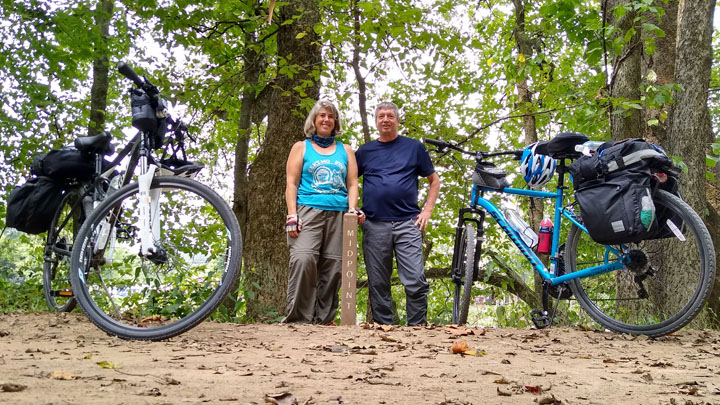Welcome to Tom and Jana's
September 2020 C&O Canal Bicycle Trip!
Now for something completely different... A 185-mile bike ride through the Chesapeake and Ohio Canal National Historic Park on the old C&O Canal Towpath, following the Potomac River from the foot of the Allegheny Mountains in Cumberland, Maryland, to the upper reaches of the Chesapeake Bay in Georgetown/Washington, D.C.
We took five days to bike the C&O Trail, staying at hotels each night in tiny towns along the way, plus another five days for travel and additional fun, including a bonus 25-mile bike ride on the Great Allegheny Passage (GAP) Rail-Trail from Deal, Pennsylvania, back to Cumberland. Transportation for us and our bikes from the Georgetown end of the trail to Deal, PA, was provided by Tom's accommodating cousin Kelly, who lives 30 minutes outside of D.C.
Once upon a time, Tom lived in the West Virginia/D.C./Baltimore metro area and occasionally visited points along the nearby C&O Canal, but it's impossible to see the whole thing without a major hike or bike ride, and he'd been wanting to do this trip for years. When he decided in late June that now's the time, at first it seemed crazy since I neither rode nor owned a bike, but when he said he was going with or without me, the challenge was on!
In spite of being in the midst of the “great bicycle shortage of 2020,” we eventually tracked down a bike for me and a new bike for Tom as well. Then we geared up with racks, panniers, helmets, etc., rode around the neighborhood for a couple of months, and were on our way.
The bikes: Nishiki Women's Anasazi hybrid, aluminum, with 700x38c tires (Jana), Schwinn Copeland hybrid, steel, also with 700x38c tires (Tom).

Jana & Tom on the C&O
Warning: Three paragraphs of C&O Canal history follow.
The idea of opening the Potomac River to navigation as a route to the west first interested George Washington when he was a young officer during the French and Indian War. When he later became president, Washington furthered the prospect of a canal along the Potomac by selecting the site of the U.S. capital city to be built on the mouth of the river near Georgetown.
After numerous delays, the Chesapeake and Ohio Canal Company finally began digging upriver from Georgetown in 1828. Construction was completed in 1850, by which time canals had been rendered all but obsolete by railroads. Nevertheless, the C&O Company continued operation of the canal until 1924, primarily shipping coal from the western mountains to markets in the east.
The C&O Canal was abandoned for almost 50 years, until the formation of the Chesapeake and Ohio Canal National Historic Park in 1971. The 184.5-mile towpath, once used by mules to pull canal boats through the waterway, is now one of the longest biking trails in the U.S. The 20,000-acre park encompasses hundreds of historic structures, including eleven aqueducts, 74 locks, numerous lockhouses, bridges, culverts, dams, mills, kilns, and the remarkable Paw Paw Tunnel.
|
